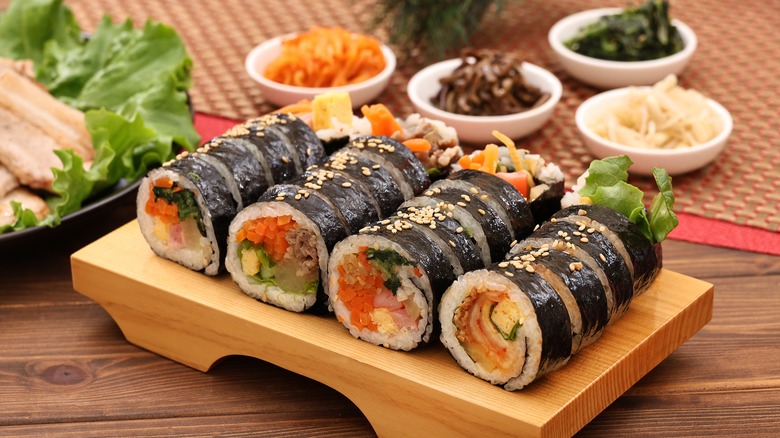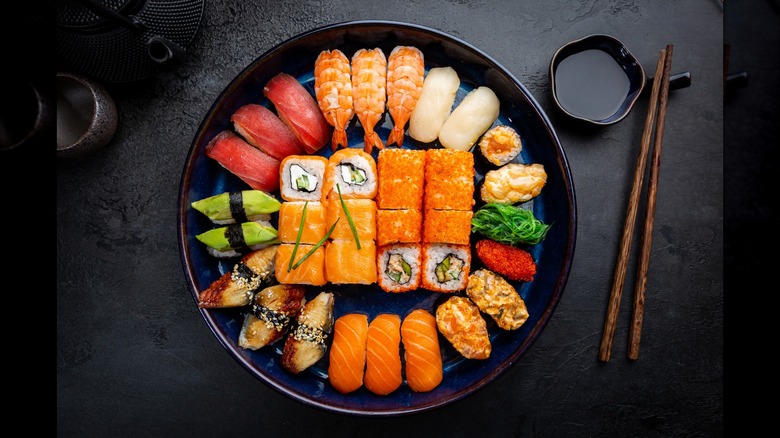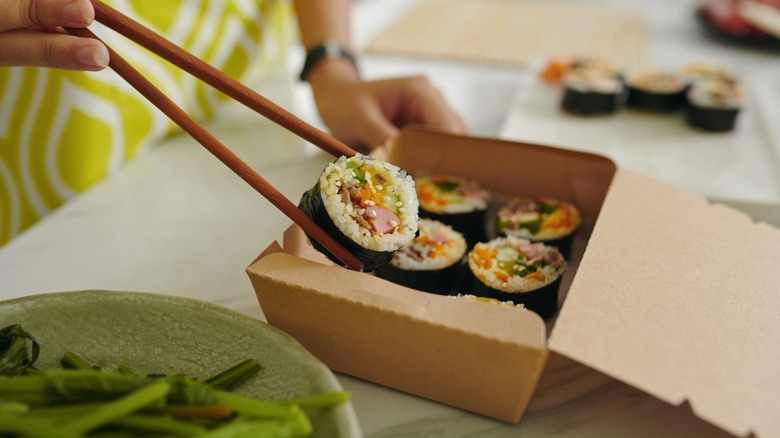The Main Differences To Note Between Kimbap And Sushi
Are you a sushi fan? Well, meet its culinary cousin, kimbap. At first glance, kimbap and sushi look quite similar: They're both long rice rolls filled with goodies and cut into bite-sized pieces. However, if you look closer or try a few slices, you'll notice several differences between them — namely flavor, ingredients, and how they're served.
Kimbap (or gimbap) is a traditional Korean dish that translates to seaweed (kim) and rice (bap). The rice is seasoned with sesame oil and salt, so you pick up a hint of sweet sesame in each bite. Typical fillings don't include raw fish, but processed meat, cheese, chopped omelet, beef, fishcake, and imitation crab. Classic veggies used include carrots, cucumbers, cabbage, spinach, and pickled radish. These rice rolls are wrapped in seaweed and sliced, and the final result is a colorful cross-section filled with salty, sweet, and sour flavors.
In contrast, sushi rice is made with vinegar, salt, and sugar, so it has a touch of acidity. In fact, sushi translates to "sour rice," and contrary to popular belief, rice is the star of sushi, not raw fish. But of course, you'll usually find raw fish in your sushi, along with fresh fillings like cucumber or avocado. Rolls are wrapped in seaweed and either topped with additional goodies like roe or sauce, or left plain. Due to the ingredients, sushi is best served fresh, while kimbap makes great takeaway — but the differences don't end there.
Styles of kimbap vs sushi
As mentioned, traditional kimbap is packed with colorful veggies and protein, but there are some different variations worth noting. Chungmu kimbap forgoes the fillings altogether and contains only rice. Samgak is in the shape of a triangle rather than a circle, and nude kimbap is made with seaweed inside the roll rather than outside. Mayak kimbap, which translates to "drug kimbap" because it's so addictive, is a small, minimalistic version of the dish. No slicing is necessary; these cute cigar-style rolls are served as finger food with a sweet mustard dip. People are also breaking with convention with their choice of fillings. Tonkatsu kimbap, for example, contains breaded pork. We've even seen kimbap with raw fish, cream cheese, and wasabi, which is the closest it gets to a sushi roll.
When Americans hear the word sushi, they immediately think of rolls like rainbow, dragon, or California. While rolls do exist in Japan, they've definitely gained more popularity Stateside. In fact, California rolls were invented in Los Angeles and only later introduced in Japan. Meanwhile, the Japanese are more likely to associate sushi with nigiri. Nigiri sushi is made of plain rice topped with fish; these tasty bites are traditionally eaten by hand. Other popular styles include maki, a skinny roll containing only one or two ingredients wrapped in rice with seaweed on the outside, and temaki, a larger roll eaten by hand.
How to eat kimbap vs sushi
Kimbap and sushi can be snacks, appetizers, or full meals and you can use chopsticks with both — but that's where the dining similarities end. Kimbap isn't typically served with sauce, but can be accompanied by kimchi, while sushi always comes with wasabi, soy sauce, and pickled ginger. When and how you eat each dish also differs. In Korea, kimbap is considered boon-shik, a cheap but tasty street food. You'll find it at street markets, convenience stores, or kimbap shops, although it's often homemade. It's traditionally consumed in casual settings and travels well. So, while you can sit down and enjoy it on the spot, it's a fantastic takeaway option. Since kimbap is eaten at room temperature, it also makes an ideal dish for picnics or social gatherings.
Meanwhile, sushi tends to be a proper sit-down affair. It often includes raw seafood, so it should be consumed on the spot, and there's more etiquette involved in eating sushi. When ordering several rolls at a restaurant, start with the lighter fish and work your way up to the richer, fattier rolls. Eat one piece at a time, dipping it into soy sauce fish-side first rather than rice first as this absorbs too much sauce. Add a bit of wasabi if desired and pop it into your mouth. Lastly, ginger shouldn't be consumed on sushi, but used as a palate cleanser, especially in between rolls.


